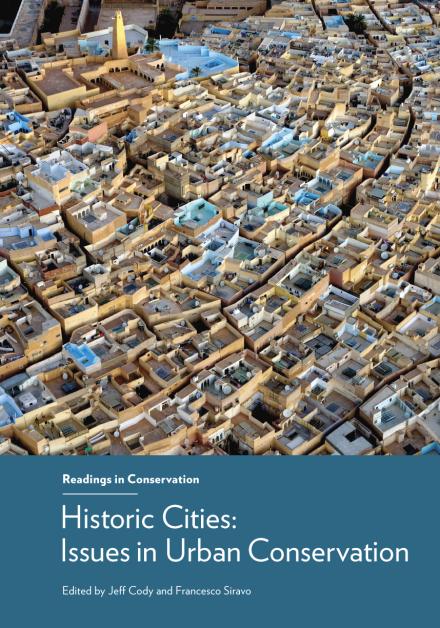Book Review: Historic Cities: Issues in Urban Conservation
Submitted by sharragrow on

Review by Graham Voce
Historic Cities: Issues in Urban Conservation (Readings in Conservation)
Edited by Jeff Cody and Francesco Siravo
Getty Conservation Institute, USA, July 2019 (US) August 2019 (UK)
632 Pages / 114 colour & 60 black and white illustrations / Paperback
ISBN 978-1-60606-593-8
Taking a broad view can often mean a loss of focus, but this volume avoids this approach, successfully bringing together a wide selection of papers and extracts of papers across cultures, geographies and time. This format makes for an impressive assembly of readings, a compactum as it were, as an essential reference resource on this broad but less appreciated conservation topic.
It is refreshing to read papers that focus away from more traditional geographical foci for built heritage conservation and instead address modern urban heritage issues in locations including the Middle East, Africa, India and Japan, among others. In each section of the book the selected papers reference each other, and the benefit of this is that urban conservation issues can be seen as universal to the human urban environment rather than being the preserve of one particular part of the globe (or, more probably, self-interestedly, one’s own part of this planet). We may consider our own urban heritage unique with its own problems and challenges, but this compilation shows that the issues are universally human.
The editors state one of their main framing concerns (if not the main concern here) as follows: “as global urbanisation runs rampant, architectural heritage becomes more imperilled, fragile and expedient… Few historic places survive the onslaught of poorly co-ordinated mal-development…”. This is reinforced by a stated awareness of the urban environment as ‘the recipient of value or memory’ (Syrian writer Marwa Al-Sabouni).
The book’s papers and selections are organised into seven sections, each followed by a “Visual Summary” of images supporting that section. These are broadly and thematically titled and cover the following: The shared nature of the historic city; The geographic diversity of historic cities; Reactions to the transformation of traditional cities (three critical ruptures); Reading the historic city; The search for contextual continuities; The search for significant value; The sustainability of urban conservation and Managing historic cities. The final appendix is a useful list of key international conventions, recommendations and charters related to urban conservation. The date range of papers too is impressive; we have contributions from Victor Hugo (1832) and John Ruskin (1854) through to the explosion of concern for this area of heritage conservation in the twentieth century and into our current millennium, with a number of papers written in particular for this new book.
The editors thus bring together papers that consider the ways in which conservation has been codified and developed, as well as the warding off of natural decay and the problems that urban growth and development (or ‘mal-development’) create. So, whereas papers such as Sir Bernard Feilden’s and Jukka Jokilehto’s paper “Management Guidelines for World Cultural Heritage Sites” and Jinnai Hidenobu’s “Tokyo: a spatial anthropology” are included as attempts at disinterested analyses and dispassionate measures and guidelines, there are also personal analyses and reactions such as Senam Okudzeto’s “Remembering African Cities: Rethinking urban conservation as radical public history. In the latter piece, commissioned for this book, Okudzeto reviews the challenge of heritage facing “flattening [of] the historical landscape and [the] eliminating [of] vernacular accents in design” in the planned national celebrations of the 50th anniversary of Ghana’s independence from the UK. The danger here is not only of losing past identities and heritages, but it also potentially presages the “creating [of] new forms of jingoism, kitsch or nationalist fervour”. Here we can interpret heritage conservation as giving voice to the realisation of the loss of ways of urban living, of aesthetic obliterations and of concerns about the urban environment being changed to articulate a new social or economic order.
One personal observation here is that there is perhaps relatively little mention of the active conservation of particular built structures or specific sites other than as refences in wider reviews—of the mechanics and aesthetics in the case of specific buildings in their contexts—but then that would be perhaps a dilution of focus too far, and that would make for a volume longer (and heavier) than the 610 pages we have here.
This is an indispensable book for its breadth and depth and its wide inclusivity of papers over times and cultures, styles and foci. It is essential to be able to have easy reference to this range of reading, research and opinion in one place. If, as quoted in this book, Sir John Summerson could, in 1963, write of an earlier colleague having started “the study of the city as an organism,” then this compilation is itself the start of a new organically-focused study of urban conservation as a whole. An essential volume.
AUTHOR BYLINE
Graham Voce is IIC’s Executive Secretary, responsible for the IIC Office team’s day-to-day workings. Since taking on this role in 2004, Graham has been involved with most of IIC’s activities including working with the organisation of (to date) seven IIC Congresses and four Student & Emerging Conservator Conferences, as well as other IIC events, activities and publications. Having studied both landscape architecture and English literature to BA (hons) degree level, Graham is a Fellow of the Society of Antiquaries of London and a member of a number of heritage organisations.